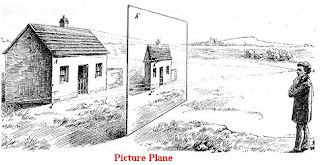
Chiaroscuro: "light-dark", using light and dark contrasts to give the illusion of depth. We can see this technique being used in The Matchmaker by Gerrit van Honthorst.
Contour Line: lines that surround and define the edges of a subject which add shape and volume. This can be shown here by this picture of shoes drawn by an artist.
pentimento: an alteration in a painting, which is evident by traces of previous work which show that the artist changed his mind during the creating of the painting.
Complementary color scheme: the use of colors that are opposite each other on the color wheel. i.e., blue and orange, red and green, purple and yellow. This scheme produces an energetic feeling and creates a vibrant look. This can be seen by the use of blues and oranges in fall glory by Spencer Williams
Analogous Color Scheme: the use of colors that are adjacent to each other on the color wheel. i.e., green, yellow green, and yellow or red, red violet and violet. These color schemes are often found in nature and are pleasing to the eye and give a bright effect, which is appealing to many changing moods. One hue should usually be the main color when using this color scheme.
Monochromatic color scheme: the use of color that consist of different values, meaning different tints and shades, of one color. These color schemes can be effective and soothing, although they are less vibrant than the others.
Inconology: the branch of knowledge that deals with the subject of icons or images. It is also the subject matter of the study of icons collectively or as objects.
Foreshortening: the visual effect or optical illusion that either an object or distance appears shorter than it is because it is angled toward the viewer. It is also the act of angling the object toward the viewer to get this affect. The best example is a painting of the Foreshortened Christ by Mantegna in 1500.
Crosshatching: creating shading effects with closely spaced parallel lines, with more such lines placed at an angle across them.
Modernism: an art movement that was characterized by an intentional departure from tradition and the use of innovative forms of expression that differentiate an abundance of styles in the arts and literature during the late 19th century and early 20th century. Hans Hofmann painted The Gate in 1960, seen below.
Post Modernism: art, architecture, or literature that reflects against the principles of early modernism such as new kinds of materials and paint and subject matters, as well as a new sense of abstract art. Post Modern art reintroduced traditional and classical elements of style. Modern ideas and concepts were also carried to their extremes. Below is an image create by John Singer Sargent called Madame X painted in 1884.
Picture plane: the plane or flat level, in perspective, that is occupied by the surface of the picture; Its frontal boundary. below is a drawing to further explain the definition. (author unknown)
Foreground: the area of a picture which is often at the bottom. It appears to be closest to the viewer. It is also to give priority to one aspect of a thing over another.
Middle ground: the part of the artwork that lies between the foreground and the background.
Background: the part of the picture that appears to be farthest away from the viewer, which is usually closest to the horizon. It is the opposite of the foreground.












No comments:
Post a Comment